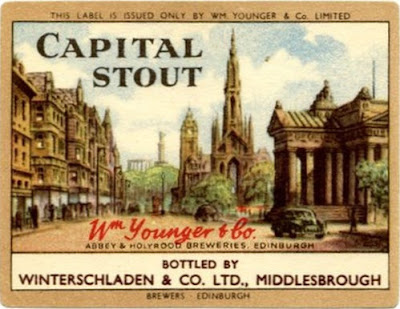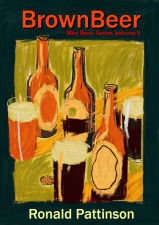This beer is very unusual for the 19th century. Usually, Sweet Stouts are associated with the addition of lactose, a practice which only started just before WW I. Yet here is a very sweet Stout from a few decades earlier. Here the sweetness comes from a very low degree of attenuation and minimal hopping.
The grist is about as simple as you can get for a Stout: just base pale malt and black malt. Quite a high percentage of the latter leaving the beer quite dark.
Getting back to the hopping, I picked this particular example because, unlike many, it contains no spent hops. Most brews contained some, or even all, spent hops.
There were quite a few different types of hops. Just not very many of them. American from the 1884 and 1885 harvests, Kent from 1884 and Bohemian from 1885.
Definitely no ageing for this beer.
| 1885 William Younger S2 Stout | ||
| pale malt | 14.00 lb | 91.80% |
| black malt | 1.25 lb | 8.20% |
| Cluster 120 min | 0.50 oz | |
| Cluster 60 min | 0.25 oz | |
| Fuggles 30 min | 0.25 oz | |
| Saaz 30 min | 0.25 oz | |
| OG | 1064 | |
| FG | 1032 | |
| ABV | 4.23 | |
| Apparent attenuation | 50.00% | |
| IBU | 19 | |
| SRM | 34 | |
| Mash at | 151º F | |
| Sparge at | 163º F | |
| Boil time | 120 minutes | |
| pitching temp | 59º F | |
| Yeast | WLP028 Edinburgh Ale | |












































































5 comments:
What is the difference a stout like this and a dark mild ale like Joseph Holt dark mild which is as black as coal?
Oscar
Hi Ron. How should a brewer keep attenuation with WLP028 down to 50%? I know black malt has no fermentable sugars, but it’s not a big enough fraction of the grain bill to knock it down from 70-75% to 50%. I expected to see a very high mash temperature, but I don’t. What did I miss? Thanks.
Hi, Ron. How did they get to 50% attenuation mashing at 151? From experience with that particular strain, I’d think the gravity would end somewhere between 1.010 and 1.012 based on a mash temp of 151F.
Roast malt.
Thanks. If you want to avoid darker brewing sugars for a mild, black wheat is the way forward.
Oscar
Post a Comment